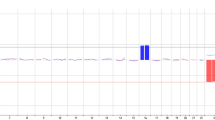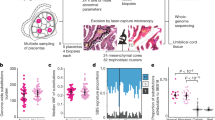Abstract
In human post-natal somatic cells, low global levels of DNA methylation have been associated with the hypomethylation of several repetitive elements, a feature that has been proposed to be a surrogate epigenetic marker. These data, mainly derived from the analysis of cancer cells, suggest a potential association between loss of cell-growth control and altered differentiation with hypomethylation of repetitive sequences. Partial hydatidiform moles (PHMs) can be used as an alternative model for investigating this association in a non-tumorigenic context. This gestational disease is characterized by abnormal overgrowth and differentiation of the placenta and spontaneous abortion. Here, we comprehensively analyse the DNA methylation of these trophoblastic tissues in both PHM and normal placenta at global and sequence-specific levels. Analysis of the global 5-methylcytosine content and immunohistochemistry indicate that PHM and normal placenta have identical global levels of DNA methylation. In contrast, bisulfite genomic sequencing shows that, whereas Alu, NBL2 and satellite 2 repetitive elements are equally methylated, LINE-1 sequences are hypermethylated in PHM tissues (∼2-fold relative to normal placenta). Interestingly, altered demethylation is also found in triploid diandric embryos that originate from dispermic fertilization of an oocyte, a common event responsible for most PHMs. In conclusion, alterations of DNA methylation do not seem to be randomly distributed in PHM, as several repeated elements remain unaltered, whereas LINE-1 sequences are hypermethylated. In addition, our findings suggest that the hypomethylation of repetitive elements in cancer is directly linked to the neoplasic process and not a simple consequence of loss of growth control observed in most of the cancer cells.
This is a preview of subscription content, access via your institution
Access options
Subscribe to this journal
Receive 50 print issues and online access
$259.00 per year
only $5.18 per issue
Buy this article
- Purchase on Springer Link
- Instant access to full article PDF
Prices may be subject to local taxes which are calculated during checkout



Similar content being viewed by others
References
Bariol C, Suter C, Cheong K, Ku SL, Meagher A, Hawkins N et al. (2003). The relationship between hypomethylation and CpG island methylation in colorectal neoplasia. Am J Pathol 162: 1361–1371.
Baylin SB . (2005). DNA methylation and gene silencing in cancer. Nat Clin Pract Oncol 2 (Suppl 1): S4–S11.
Chalitchagorn K, Shuangshoti S, Hourpai N, Kongruttanachok N, Tangkijvanich P, Thong-ngam D et al. (2004). Distinctive pattern of LINE-1 methylation level in normal tissues and the association with carcinogenesis. Oncogene 23: 8841–8846.
Chen H, Ye D, Xie X, Lu W, Zhu C, Chen X . (2005). PTEN promoter methylation and protein expression in normal early placentas and hydatidiform moles. J Soc Gynecol Investig 12: 214–217.
Ehrlich M . (2002). DNA methylation in cancer: too much, but also too little. Oncogene 21: 5400–5413.
Esteller M . (2005). Aberrant DNA methylation as a cancer-inducing mechanism. Annu Rev Pharmacol Toxicol 45: 629–656.
Feinberg AP, Gehrke CW, Kuo KC, Ehrlich M . (1988). Reduced genomic 5-methylcytosine content in human colonic neoplasia. Cancer Res 48: 1159–1161.
Fraga MF, Esteller M . (2002). DNA methylation: a profile of methods and applications. Biotechniques 33: 636–649.
Gama-Sosa MA, Midgett RM, Slagel VA, Githens S, Kuo KC, Gehrke CW et al. (1983a). Tissue-specific differences in DNA methylation in various mammals. Biochim Biophys Acta 740: 212–219.
Gama-Sosa MA, Wang RY, Kuo KC, Gehrke CW, Ehrlich M . (1983b). The 5-methylcytosine content of highly repeated sequences in human DNA. Nucleic Acids Res 11: 3087–3095.
Genest DR . (2001). Partial hydatidiform mole: clinicopathological features, differential diagnosis, ploidy and molecular studies, and gold standards for diagnosis. Int J Gynecol Pathol 20: 315–322.
Ghabreau L, Roux JP, Niveleau A, Fontaniere B, Mahe C, Mokni M et al. (2004). Correlation between the DNA global methylation status and progesterone receptor expression in normal endometrium, endometrioid adenocarcinoma and precursors. Virchows Arch 445: 129–134.
Hjelle BL, Phillips III JA, Seeburg PH . (1982). Relative levels of methylation in human growth hormone and chorionic somatomammotropin genes in expressing and non-expressing tissues. Nucleic Acids Res 10: 3459–3474.
Hoffmann MJ, Schulz WA . (2005). Causes and consequences of DNA hypomethylation in human cancer. Biochem Cell Biol 83: 296–321.
Issa JP . (2004). CpG island methylator phenotype in cancer. Nat Rev Cancer 4: 988–993.
Jackson K, Yu MC, Arakawa K, Fiala E, Youn B, Fiegl H et al. (2004). DNA hypomethylation is prevalent even in low-grade breast cancers. Cancer Biol Ther 3: 1225–1231.
Jeanpierre M . (1994). Human satellites 2 and 3. Ann Genet 37: 163–1671.
Judson H, Hayward BE, Sheridan E, Bonthron DT . (2002). A global disorder of imprinting in the human female germ line. Nature 416: 539–542.
Lee C, Wevrick R, Fisher RB, Ferguson-Smith MA, Lin CC . (1997). Human centromeric DNAs. Hum Genet 100: 291–304.
Magdinier F, Billard LM, Wittmann G, Frappart L, Benchaib M, Lenoir GM et al. (2000). Regional methylation of the 5′ end CpG island of BRCA1 is associated with reduced gene expression in human somatic cells. FASEB J 14: 1585–1594.
Magdinier F, D’Estaing SG, Peinado C, Demirci B, Berthet C, Guerin JF et al. (2002). Epigenetic marks at BRCA1 and p53 coding sequences in early human embryogenesis. Mol Hum Reprod 8: 630–635.
Magdinier F, Ribieras S, Lenoir GM, Frappart L, Dante R . (1998). Down-regulation of BRCA1 in human sporadic breast cancer; analysis of DNA methylation patterns of the putative promoter region. Oncogene 17: 3169–3176.
Morgan HD, Santos F, Green K, Dean W, Reik W . (2005). Epigenetic reprogramming in mammals. Hum Mol Genet 14 (Spec No. 1): R47–R58.
Nishiyama R, Qi L, Lacey M, Ehrlich M . (2005). Both hypomethylation and hypermethylation in a 0.2-kb region of a DNA repeat in cancer. Mol Cancer Res 3: 617–626.
Rollins RA, Haghighi F, Edwards JR, Das R, Zhang MQ, Ju J et al. (2006). Large-scale structure of genomic methylation patterns. Genome Res 16: 157–163.
Tavassoli FA, Devilee P . (2003). World Health Organization Classification of Tumors. Pathology and Genetics of Tumors of the Breast and Female Genital Organs. IARC Press: Lyon, France.
Tsien F, Fiala ES, Youn B, Long TI, Laird PW, Weissbecker K et al. (2002). Prolonged culture of normal chorionic villus cells yields ICF syndrome-like chromatin decondensation and rearrangements. Cytogenet Genome Res 98: 13–21.
Weisenberger DJ, Campan M, Long TI, Kim M, Woods C, Fiala E et al. (2005). Analysis of repetitive element DNA methylation by MethyLight. Nucleic Acids Res 33: 6823–6836.
Widschwendter M, Jiang G, Woods C, Muller HM, Fiegl H, Goebel G et al. (2004). DNA hypomethylation and ovarian cancer biology. Cancer Res 64: 4472–4480.
Yang AS, Estecio MR, Doshi K, Kondo Y, Tajara EH, Issa JP . (2004). A simple method for estimating global DNA methylation using bisulfite PCR of repetitive DNA elements. Nucleic Acids Res 323: e38.
Young LE, Beaujean N . (2004). DNA methylation in the preimplantation embryo: the differing stories of the mouse and sheep. Anim Reprod Sci 82–83: 61–78.
Zaragoza MV, Surti U, Redline RW, Millie E, Chakravarti A, Hassold TJ . (2000). Parental origin and phenotype of triploidy in spontaneous abortions: predominance of diandry and association with the partial hydatidiform mole. Am J Hum Genet 66: 1807–1820.
Acknowledgements
We thank Nabiha Missaoui for her help with the immunochemical analysis, and to Dr Jacqueline Lornage and the members of the Laboratory of Reproductive Biology team for collecting human gametes and triploid embryos. We also thank Dr A Niveleau for the generous gift of anti-5-MeCyt antibodies. The present work was supported by the Ligue Nationale contre le Cancer (Comité du Rhône); the Association pour la Recherche sur le Cancer; Organon, Serifontaine, France; the Institut National de la Santé et de la Recherche Médicale (Réseau Développement Embryonnaire) and the Institut National contre le Cancer (EpiPro).
Author information
Authors and Affiliations
Corresponding author
Additional information
Supplementary Information accompanies the paper on the Oncogene website (http://www.nature.com/onc).
Rights and permissions
About this article
Cite this article
Perrin, D., Ballestar, E., Fraga, M. et al. Specific hypermethylation of LINE-1 elements during abnormal overgrowth and differentiation of human placenta. Oncogene 26, 2518–2524 (2007). https://doi.org/10.1038/sj.onc.1210039
Received:
Revised:
Accepted:
Published:
Issue Date:
DOI: https://doi.org/10.1038/sj.onc.1210039
Keywords
This article is cited by
-
A potential new mechanism for pregnancy loss: considering the role of LINE-1 retrotransposons in early spontaneous miscarriage
Reproductive Biology and Endocrinology (2020)
-
Insulin-like growth factor axis in pregnancies affected by fetal growth disorders
Clinical Epigenetics (2016)
-
Patterns and functional roles of LINE-1 and Alu methylation in the keratinocyte from patients with psoriasis vulgaris
Journal of Human Genetics (2015)
-
Detection of global DNA methylation and paternally imprinted H19 gene methylation in preeclamptic placentas
Hypertension Research (2011)
-
Long interspersed nuclear element-1 hypomethylation in cancer: biology and clinical applications
Clinical Epigenetics (2011)



